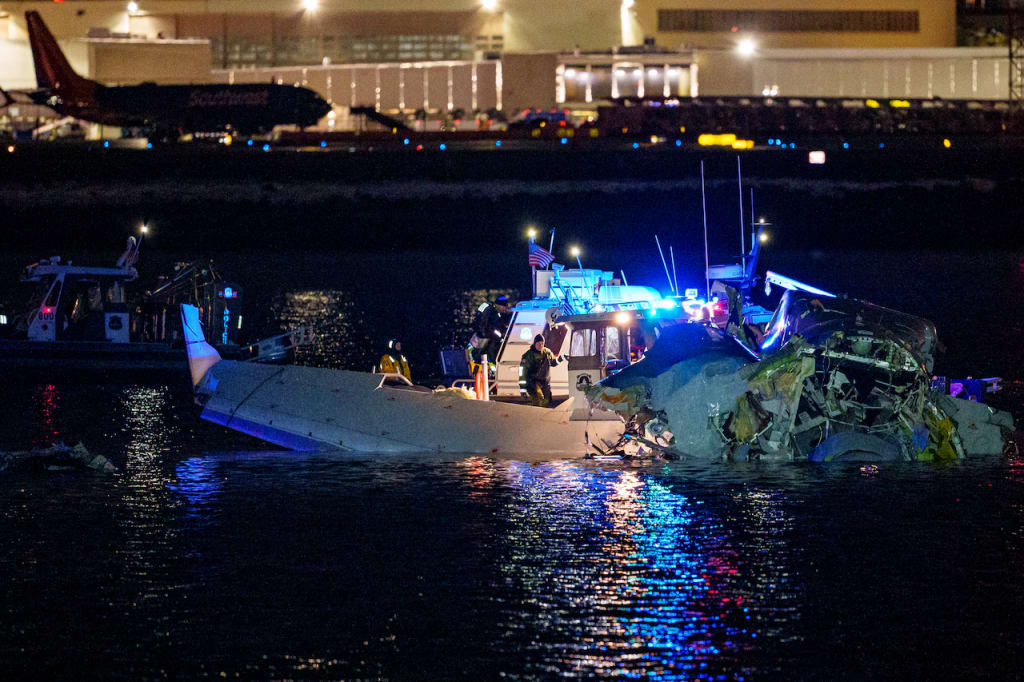News | February 20th, 2025
Fatal Flights Plane Crashes in the First Weeks of 2025
By: Jayda Nelms | Staff Writer

Aviation Safety By the Numbers
- 16 years since the last major commercial aviation disaster in the U.S.
- 300+ FAA employees terminated in early 2025.
- 19 injuries reported in the Philadelphia crash.
- 1 mid-air collision resulting in mass casualties.
In the early weeks of 2025, the United States has experienced a series of catastrophic airplane incidents, prompting urgent discussions about air travel safety.
Major Incidents
Mid-Air Collision Near Washington, D.C.
On Jan. 29, a tragic mid-air collision occurred between an American Airlines passenger jet and a U.S. Army Black Hawk helicopter near Ronald Reagan Washington National Airport, resulting in the loss of all 67 individuals aboard both aircraft.
“The Blackhawk helicopter was flying too high, by a lot. It was far above the 200-foot limit,” President Trump said in a Truth Social post.
Preliminary reports from the National Transportation Safety Board suggest that the helicopter crew may have missed important air traffic controller instructions due to an incomplete radio transmission, potentially caused by overlapping communications. The Black Hawk, on a routine training flight, collided with the descending jet at approximately 300 feet.
Fatal Crash in Northeast Philadelphia
On Jan. 31, a medical transport plane, a Learjet 55 operated by Jet Rescue Air Ambulance, crashed shortly after takeoff from Northeast Philadelphia Airport. The aircraft, going to Missouri, went down approximately 3.5 miles from the airport in a residential neighborhood near Roosevelt Mall. All six individuals on board, including a patient, her mother, and four crew members, died. One person on the ground was also killed, and 19 others were injured.
“The medical transport jet carrying a patient and her mother back to Mexico was in the air less than a minute before it plunged to the ground,” NBC10 Philadelphia reported.
The Federal Aviation Administration (FAA) and National Transportation Safety Board (NTSB) are investigating the crash, with reports indicating possible engine failure.
Small Plane Crash in Covington, Georgia
On Feb. 15, a single-engine Rockwell Commander aircraft crashed shortly after takeoff from Covington Municipal Airport, 35 miles east of Atlanta, Georgia. The plane went down around 11:40 p.m. in the woods just north of the runway, resulting in the deaths of James and Janet Hardee of Covington.
“The aircraft took off at approximately 11:00 p.m. There was no further communication from the aircraft after takeoff,” the FAA stated.
The FAA and NTSB are investigating the cause of the crash.
Industry and Government Responses
FAA Workforce Reductions Raise Concerns
In the wake of these incidents, the Trump administration terminated several hundred FAA employees, including air traffic controllers. The Professional Aviation Safety Specialists union expressed concerns, stating that the terminations were not due to performance or conduct issues and could intensify existing understaffing problems.
Government Reforms
Elon Musk’s Department of Government Efficiency team is scheduled to visit the FAA Air Traffic Control command center in Warrenton, Virginia, to assess and propose reforms to the air traffic system. Transportation Secretary Sean Duffy emphasized the initiative’s goal to enhance safety protocols. However, critics argue that Musk’s previous conflicts with FAA regulations could be a problem.
Implications for Travelers and the Aviation Industry
The recent increase in crashes has ended a 16-year period of relative safety in U.S. commercial aviation. Travelers may experience increased anxiety, potential flight delays, and stricter safety protocols as the industry deals with these challenges.
The aviation industry faces immense pressure to implement safety reforms, including reevaluating staffing policies, investing in advanced communication technologies, and enhancing training programs for both pilots and air traffic controllers.
Collaborative efforts between government agencies and industry stakeholders will be essential to restoring public trust in air travel. The coming months will determine whether these recent tragedies serve as a wake-up call for safety improvements.





